[Insider 46] I make a cheat sheet for every podcast episode.
and why I still write by hand in the age of typing.
Dear Insiders,
Recording a long-form conversation can be a lot of work. Doing so when it is your first time speaking with a stranger is a whole other level of difficulty! And I am, despite what you may have heard, a lazy person.
So how does it work?
In today’s post, I want to share my guest-research process for the SneakyArt Podcast in the form of cheat sheets that I prepare for every episode.
I want to show you how I navigate these (often) first conversations with another person, to reach subjects that are deep, insightful, and honest.
Free readers, this post is brought to you by SneakyArt Insiders. Join the circle of readers and super-listeners who allow me to do my best work.
✍🏼 The importance of writing in my life
Writing by hand has been supremely influential in all the things I am today. The writer Joan Didion said -
“I write in order to know what I think.”
I could not agree more.
While in class, I listened to my teachers, processed what they said, and wrote things down as they made sense to me. Listening, processing, and then writing. This was how I learned, and it was subtly different from what my classmates did.
After school hours, my classmates attended a range of private tuitions. Countless hours every week were given to chasing the Great Indian Dream — of clearing the (incredibly difficult) entrance exams for higher education in India.
I had zero tuitions. I was the only person I knew in the whole world who came home from school and did as they pleased. During the ages of 14-17, while everyone around me memorized long formulae of organic chemistry, I played sports, wrote stories, and read books.
(This was not because I knew better. All the credit goes to my parents. I do not know if we explicitly spoke about it but their concern was always to see if I was learning, not to push me to be #1 in class. Because I always loved to learn things, they had nothing to fear.)
I did well in school, I did well in university, I have a Master’s degree in Mechanical Engineering, and I nearly got a Ph.D in Neuroscience. I made notes by hand through all of this.
Relatedly, I am currently reading Luke Burgis’ Wanting. It is helping me understand the role of mimetic desire in society, i.e. the things we do simply in imitation of other people.
When I was growing up in Kolkata, all good desire had to be mimetic. It was virtuous to want what others agreed were things worth wanting. Bad desire was when you had your own ideas that led you away from the pack.
I grew up in a home environment that let me have my own ideas. Although I would become an engineer out of mimesis, the seed of independent decision-making had already been planted.
💻 Writing in the Age of Typing
Today I use Google Docs, Notion and Calendar. But I continue to write by hand. Some part of everything you have read from me was first expressed on paper with my Lamy fountain pen.
Why? Because I type too fast for my own good.
My words outpace my thoughts. I type, select, edit, and re-type. This goes on and on until I come to the right words. I spit out half-formed ideas and give them form on the screen.
But writing by hand enforces a physical speed limit. I cannot write faster than my thoughts. By the time I finish writing a sentence, the thought has been carefully examined, observed, and processed in my mind.
After I write a sentence, I know exactly what I was thinking. After I type a sentence, I have to go back to it.
And thus we arrive at the cheat sheets I prepare before every podcast recording.
🎙 Podcast Research
I am lucky that my guests are artists. Most of them do not have a large body of writing. If I was speaking with people deeply concerned with words, I would be obliged to also read those words. Lucky me!
Research about the artist begins with their art. While it does not have to be art I would emulate, it needs to pique my interest. The second step is to make a list of useful links about their life - website, interviews, and news media. I then make my first notes and let the raw information bounce around my mind for a few days. I know I am ready to speak with a guest when I have 4 or 5 subjects of interest.
Or, as I like to think of them, rabbit holes!
📝 Making (and Using) Cheat Sheets
It begins with a word cloud. I write the important tags (or keywords) that define the person. And I connect them to each other with events from their life and other ideas from their work.
In Episode 41 with Don Low (below), my prime fascination was his journey from engineer to artist. So instead of approaching things chronologically, I wanted our conversation to also resemble the spiral of the word cloud.
While there were many things interesting about his work, all else seemed to revolve around the fact that one day Don decided to defy the societal obligations of his world. He had made the great individual decision to chase his dreams. In different ways, throughout the conversation, we kept returning to this theme.
When planning conversations, I tend to ignore the chronological order of events. Chronologies are boring. Life is not a straight line. Time is not a straight line either.
Cheat sheets are most important as a visual map of ideas. During the conversation, one glance can tell me where we are, how deep we have gone, and where we should go next.
This was a particular challenge while recording with Jim Richards for what would become Episodes 43 and 44 (below). Both of us took a lot of joy from this conversation as every topic we touched on led to wonderful, unexpected detours. As a result, we talked for nearly 4 hours without discussing his art at all!
Above, in black fountain pen ink is the first layer of notes. I made the word cloud, connections between the words, and pulled conversation topics out of those connections.
In red is the second layer of notes, made the day before the recording. The intent is to impose a structure on my amalgam of ideas, and take note of key phrases. If I have half a second to glance at the sheet while speaking, these are the words that leap off the page.
Cheat sheets are invaluable as notes for the conversation, but often they are also notes from the conversation. Notes taken during the recording are above in black as well (made with a ballpoint pen).
The third layer of notes is thus for the anecdotes, quotes, and ideas I want to return to afterwards, but without interrupting my guest’s flow.
In the above spread, you can see hastily scribbled notes reminding me to bring up Peter’s Principle, Arthur Danto’s End of Art essay, Goodhart’s Law, and the other artists Jim cited as inspiration.
The cheat sheet for Ep 45 with Mike Shisler is a lot clearer because I was able to find a blue-ink pen to take notes during the recording. It is Layer 1 in black, Layer 2 in red, Layer 3 in blue.
The job of a cheat sheet is not to be read in full. It is a milestone along the side of the road during a long journey. It tells you where else you can go, and how far it is.
So I have to do less preparation when I speak to a guest with whom I have spoken before. For Episode 48 with Alvin Chong, I did not have to do very much because Alvin and I had already spoken at length during Instagram Live sessions on his channel. I needed only a brief list of topics, and I could trust that we would have a productive, enriching conversation out of that.
In the cheat sheet (below), everything on the right hand side page was written during the recording.
It was not part of a grand design to have a cheat sheet for every episode. It has evolved in the way of all good things - from a process of trial and error.
I began with notes on Notion and Roam Research. I would ask guests to excuse the sound of my keyboard while they spoke. But digital solutions have not been good enough for me to create a mental map in the way that I can on paper. As I grew frustrated with typing, my mind retreated to the comfort of writing. And that is where I found what works for me.
It may not work for you. And that’s okay. If you are engaged in similar work as me, you are probably also on a similar journey - figuring out a combination of digital and analog devices that will help you achieve your results. If so, consider bringing writing back into your life.
Above is the cheat sheet for my latest episode (Ep 49) with Gavin Snider. If you have finished the episode, you may notice here several topics we did not end up discussing. This is because, just like with Jim Richards, this conversation went in lots of wonderful, unexpected directions! My third layer of notes is in pencil.
Dear Insider, I would love to hear from you about how you do research. Do you also have a hybrid approach?
Thank you for reading. Thank you for giving me a space in your inbox. And thank you for your generous support of my work.




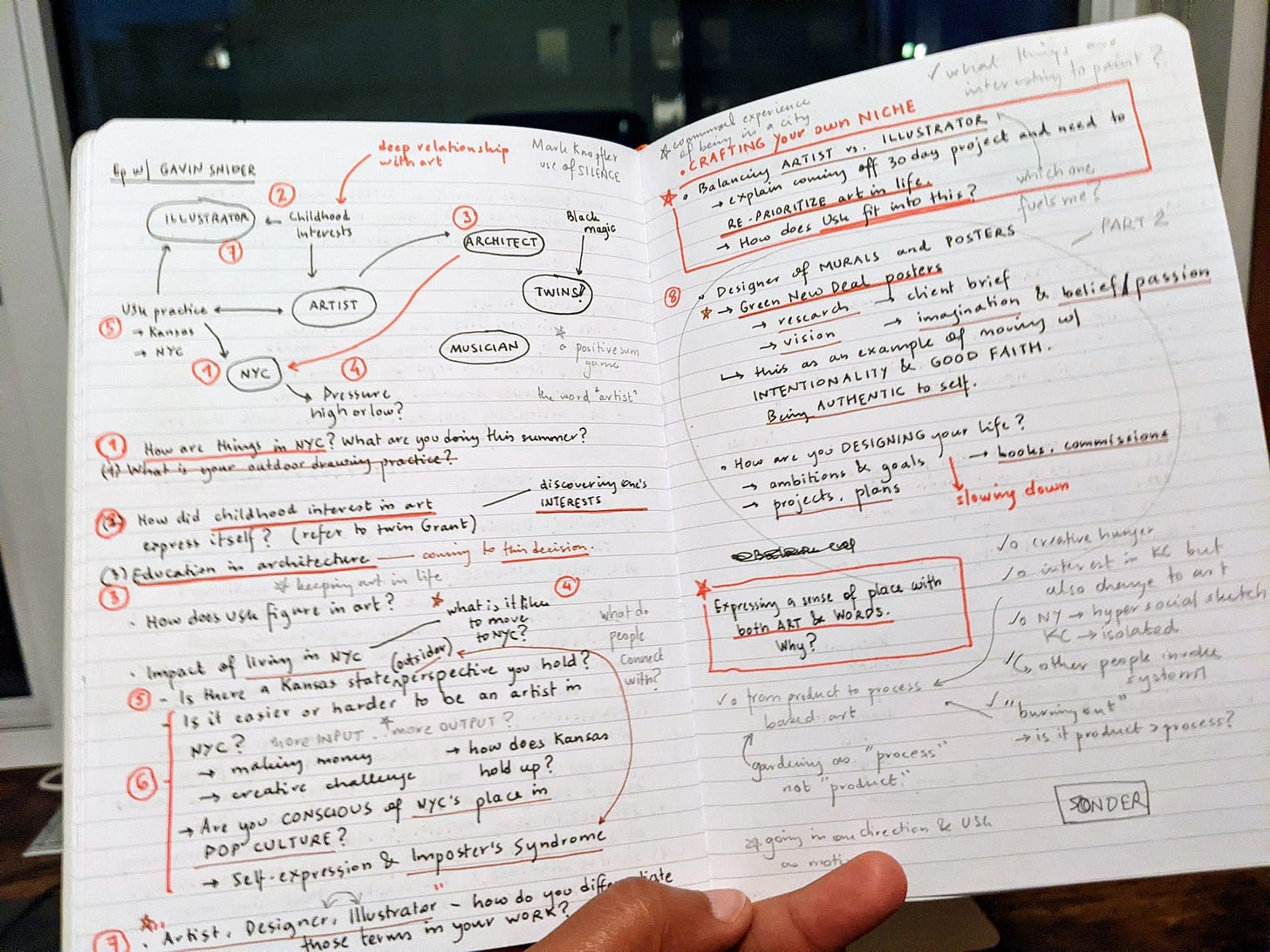



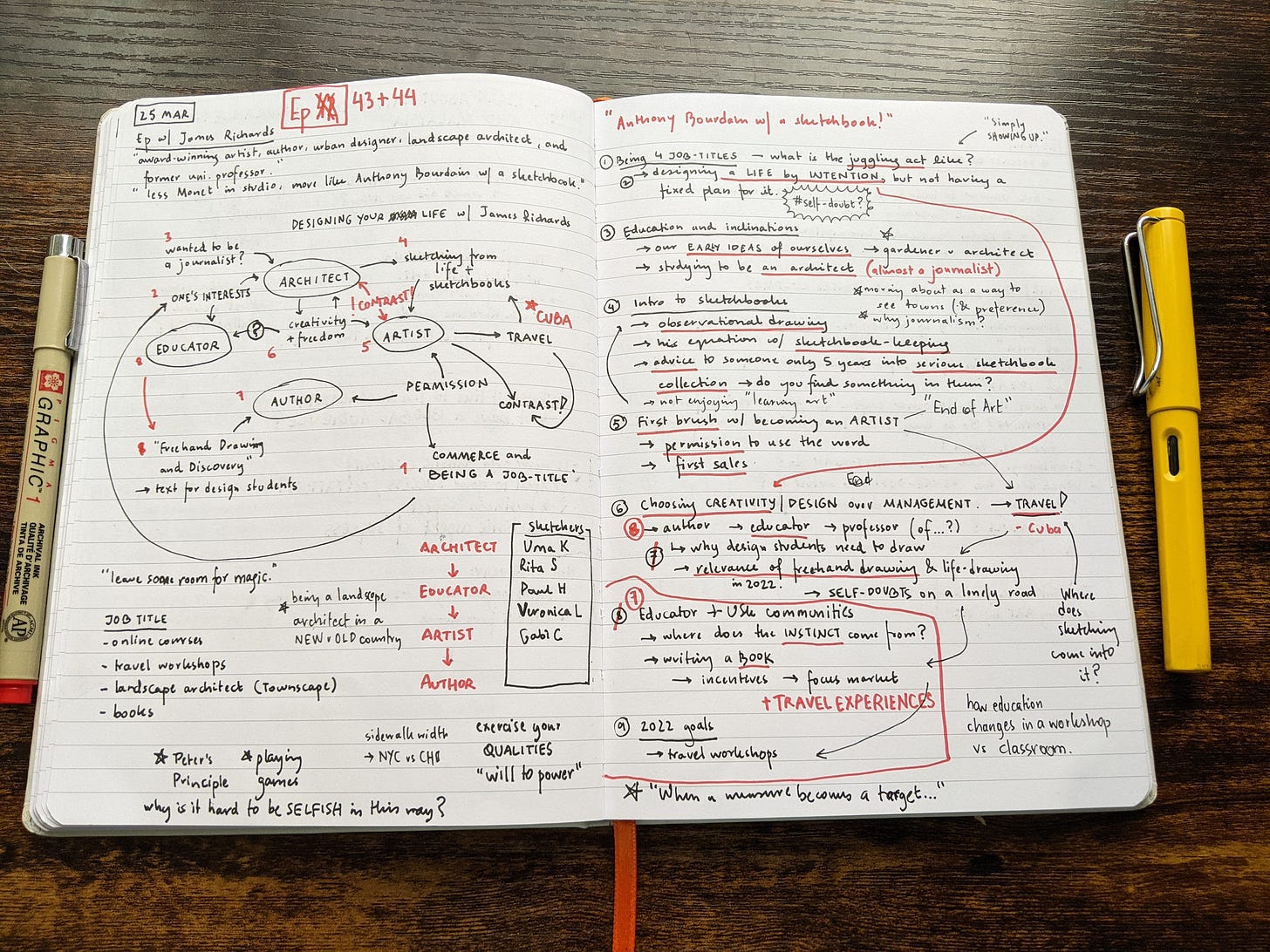
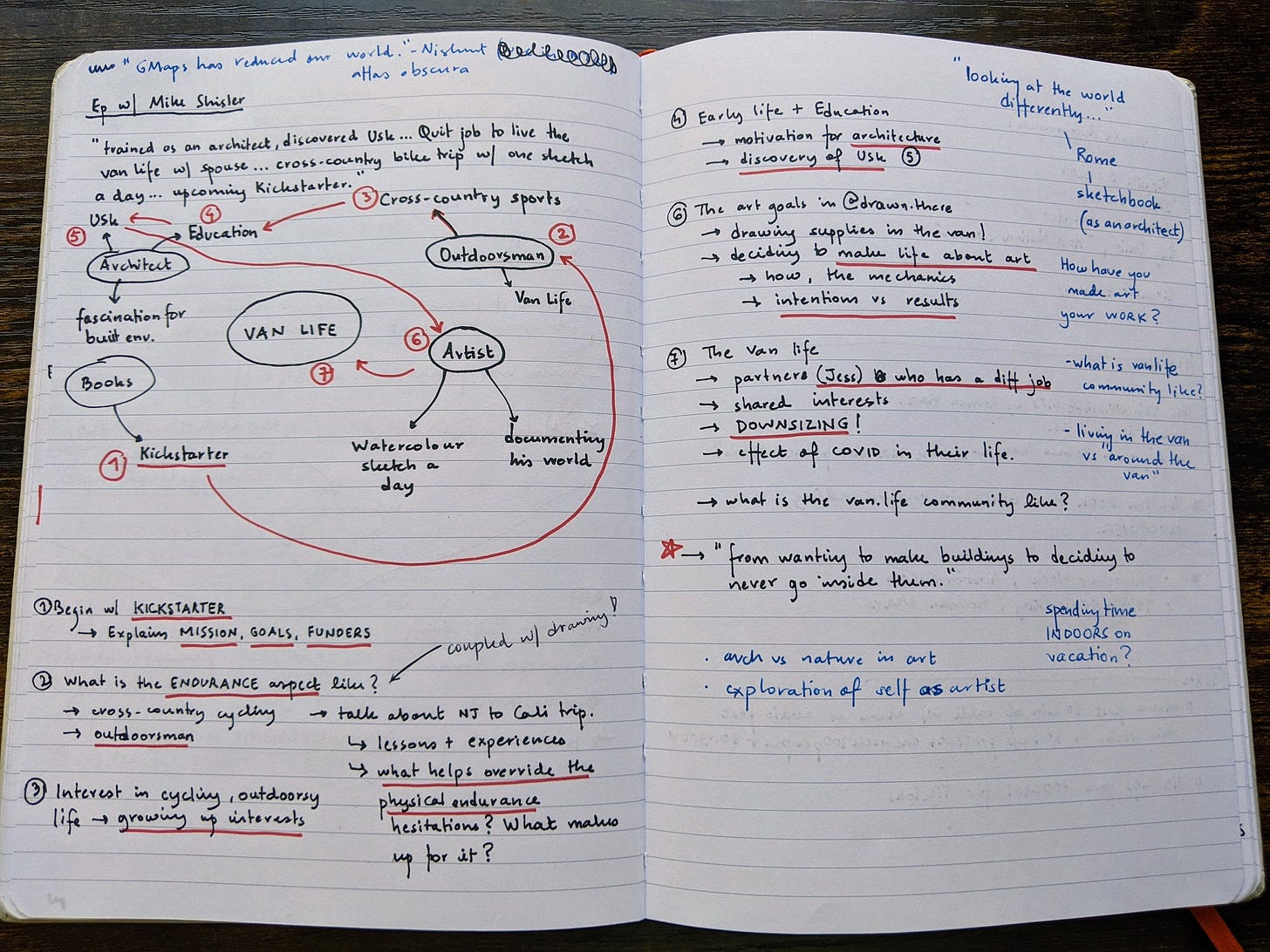
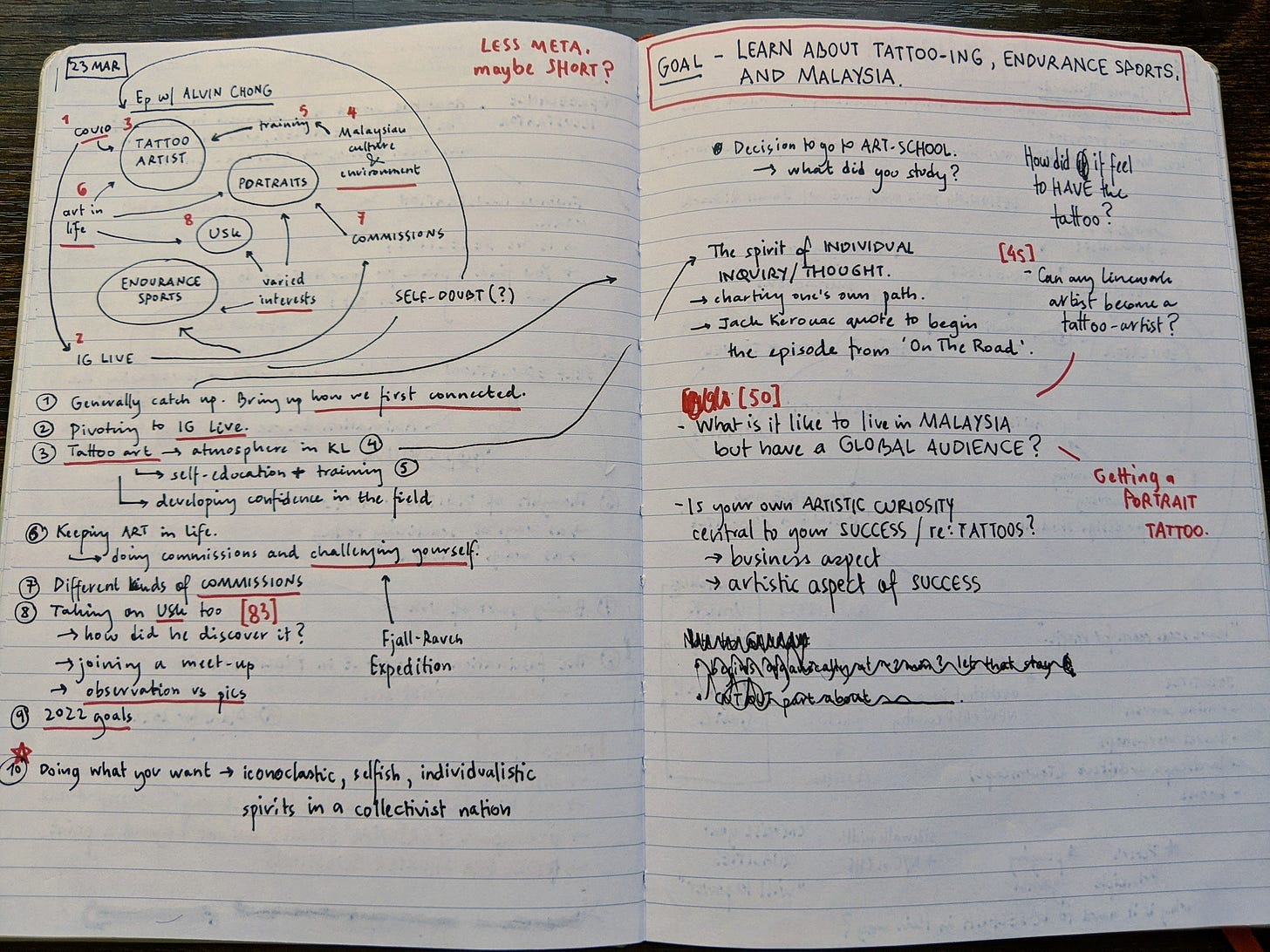
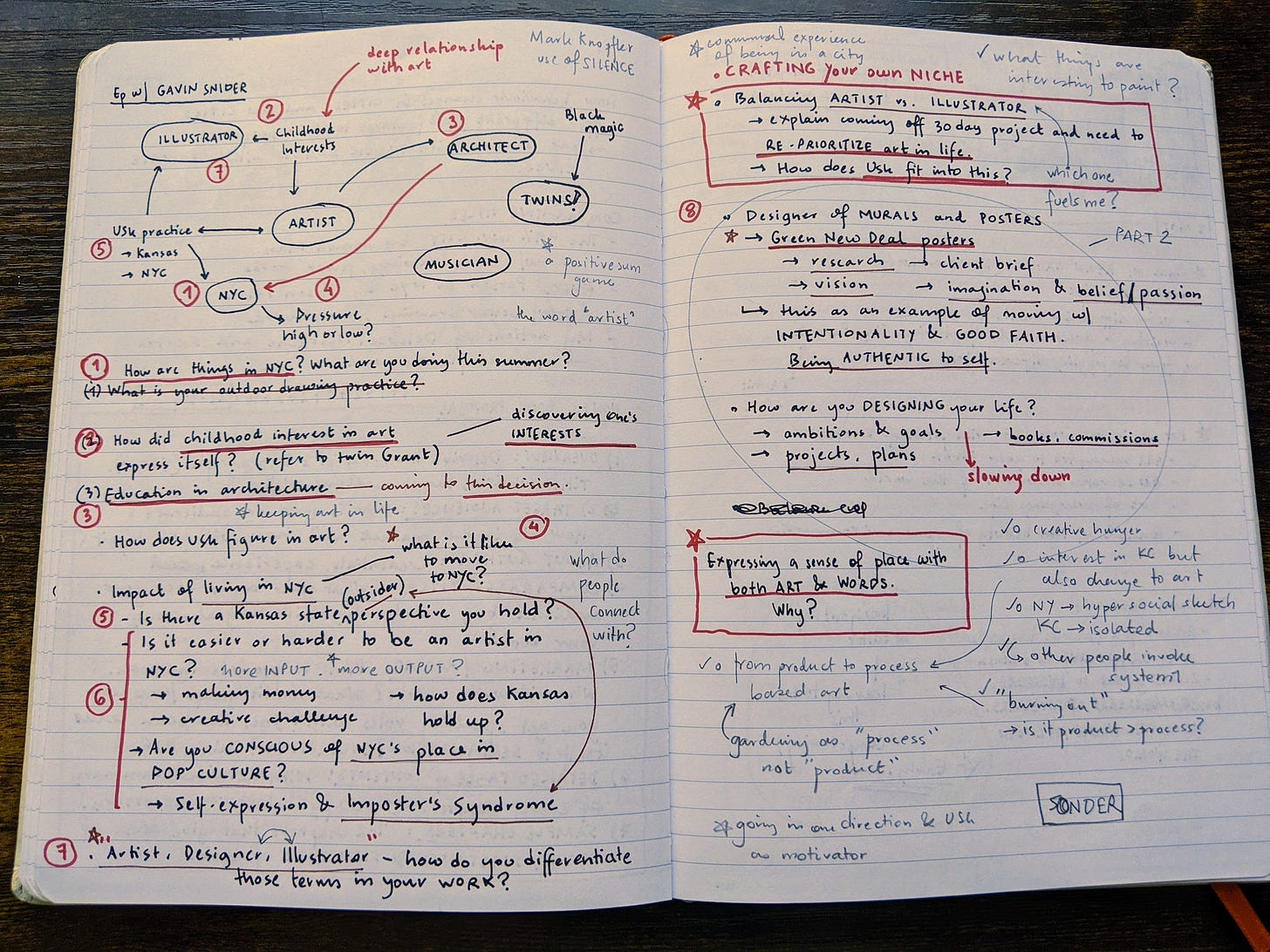

Thank you for giving us a peek into your process! Wonderfully detailed. Question: What part of your process are you least confident will scale well? And, knowing so, does your approach to it change? This could be a dead-end question but I thought I can be curious here.